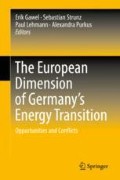Abstract
Germany’s large-scale deployment of RES-based power generation has not resulted in a significant decline of its energy-related CO2 emissions. The reason for this emissions trend was the constantly high level of coal-fired power generation in Germany. Consequently, it has been argued that the German coal binge may be the “dark side” of the Energiewende. We point out that this argumentation is flawed. In fact, the increase in coal-fired generation has been strongly driven by developments on international fuel and carbon markets—and not only, if at all, by the phase-out of nuclear and ongoing RES deployment.
Access this chapter
Tax calculation will be finalised at checkout
Purchases are for personal use only
References
AGEB. (2017). Auswertungstabellen zur Energiebilanz Deutschland – 1990 bis 2016. Berlin: Arbeitsgemeinschaft Energiebilanzen (AGEB) e.V.
Arte. (2014, March 30). Deutschland: Die Energie-Wende und die Sorben. Retrieved January 21, 2015, from http://info.arte.tv/de/deutschland-die-energie-wende-und-die-sorben
BAFA. (2018). Drittlandskohlepreis. Eschborn: Bundesamt für Wirtschaft und Ausfuhrkontrolle (BAFA). Retrieved February 19, 2018, from http://www.bafa.de/DE/Energie/Rohstoffe/Drittlandskohlepreis/drittlandskohlepreis_node.html
BMWi. (2016). Fifth “energy transition” monitoring report: The energy of the future. 2015 reporting year. Berlin: Bundesministerium für Wirtschaft und Energie (BMWi).
Böhringer, C., & Rosendahl, K. E. (2010). Green Promotes the Dirtiest: On the Interaction between Black and Green Quotas in Energy Markets. Journal of Regulatory Economics, 37, 316–325.
Böhringer, C., & Rosendahl, K. E. (2011). Greening electricity more than necessary: On the cost implications of overlapping regulation in EU climate policy. Schmollers Jahrbuch, 131, 469–492.
Bruninx, K., Madzharov, D., Delarue, E., & D’haeseleer, W. (2013). Impact of the German nuclear phase-out on Europe’s electricity generation—A comprehensive study. Energy Policy, 60, 251–261.
EEX. (2018). European emission allowances. Leipzig: European Energy Exchange (EEX). Retrieved February 19, 2018, from https://www.eex.com/de/marktdaten/umweltprodukte/spotmarkt/european-emission-allowances%2D%2D-global-environmental-exchange/47258#!/2018/02/19
Gawel, E., Lehmann, P., Korte, K., Strunz, S., Bovet, J., Köck, W., Massier, P., Löschel, A., Schober, D., Ohlhorst, D., Tews, K., Schreurs, M., Reeg, M., & Wassermann, S. (2014a). The future of the energy transition in Germany. Energy, Sustainability and Society, 4, 15.
Gawel, E., Strunz, S., & Lehmann, P. (2014b). A public choice view on the climate and energy policy mix in the EU—How do the emissions trading scheme and support for renewable energies interact? Energy Policy, 64, 175–182.
Guardian. (2014, August 27). New coal power stations threat to EU’s emissions target. Retrieved February 5, 2018, from http://www.theguardian.com/environment/2014/aug/27/coal-power-stations-eu-emissions-target
Hintermann, B., Peterson, S., & Rickels, W. (2016). Price and market behavior in Phase II of the EU ETS: A review of the literature. Review of Environmental Economics and Policy, 10, 108–128.
Hoppmann, J., Huenteler, J., & Girod, B. (2014). Compulsive policy-making—The evolution of the German feed-in tariff system for solar photovoltaic power. Research Policy, 43, 1422–1441.
IEA. (2016). Coal medium-term market report 2016 – executive summary. Paris: International Energy Agency (IEA).
Kunze, C., & Becker, S. (2014). Energy democracy in Europe: A survey and outlook, july 2014, energy democracy in Europe: A survey and outlook. Berlin: Rosa-Luxemburg-Stiftung.
Lehmann, P., & Gawel, E. (2013). Why should support schemes for renewable electricity complement the EU emissions trading scheme? Energy Policy, 52, 597–607.
Lehmann, P., Gawel, E., & Strunz, S. (2019). EU climate and energy policy beyond 2020: Are additional targets and instruments for renewables economically reasonable? In E. Gawel, S. Strunz, P. Lehmann, & A. Purkus (Eds.), The European dimension of Germany’s energy transition: Opportunities and conflicts. Heidelberg: Springer.
National Geographic. (2014, February 13). Germany plans to raze towns for brown coal and cheap energy. Retrieved February 04, 2018, from https://news.nationalgeographic.com/news/energy/2014/02/140211-germany-plans-to-raze-towns-for-brown-coal/
New York Times. (2014, February 19). German village resists plans to strip it away from the coal underneath. Retrieved February 2, 2018, from http://www.nytimes.com/2014/02/19/world/europe/german-village-resists-plans-to-strip-it-away-for-the-coal-underneath.html?_r=0
Nicolosi, M. (2010). Wind power integration and power system flexibility – An empirical analysis of extreme events in Germany under the new negative price regime. Energy Policy, 38, 7257–7268.
Pahle, M. (2010). Germany’s dash for coal: Exploring drivers and factors. Energy Policy, 38, 3431–3442.
Smith, A., Chewpreecha, U., Mercure, J.-F., & Pollitt, H. (2019). EU climate and energy policy beyond 2020: Is a single target for GHG reduction sufficient? In E. Gawel, S. Strunz, P. Lehmann, & A. Purkus (Eds.), The European dimension of Germany’s energy transition: Opportunities and conflicts. Heidelberg: Springer.
Strunz, S., Gawel, E., & Lehmann, P. (2015). Towards a general “Europeanization” of EU member states’ energy policies? Economics of Energy and Environmental Policy, 4, 143–159.
Strunz, S., Gawel, E., & Lehmann, P. (2016). The political economy of renewable energy policies in Germany and the EU. Utilities Policy, 42, 33–41.
UBA. (2017). National trend tables for the German atmospheric emission reporting 1990–2015. Dessau: Umweltbundesamt (UBA).
Ueckerdt, F., Hirth, L., Luderer, G., & Edenhofer, O. (2013). System LCOE: What are the costs of variable renewables? Energy, 63, 61–75.
Author information
Authors and Affiliations
Corresponding author
Editor information
Editors and Affiliations
Rights and permissions
Copyright information
© 2019 Springer Nature Switzerland AG
About this chapter
Cite this chapter
Kunze, C., Lehmann, P. (2019). The Myth of the Dark Side of the Energiewende . In: Gawel, E., Strunz, S., Lehmann, P., Purkus, A. (eds) The European Dimension of Germany’s Energy Transition. Springer, Cham. https://doi.org/10.1007/978-3-030-03374-3_14
Download citation
DOI: https://doi.org/10.1007/978-3-030-03374-3_14
Published:
Publisher Name: Springer, Cham
Print ISBN: 978-3-030-03373-6
Online ISBN: 978-3-030-03374-3
eBook Packages: EnergyEnergy (R0)

